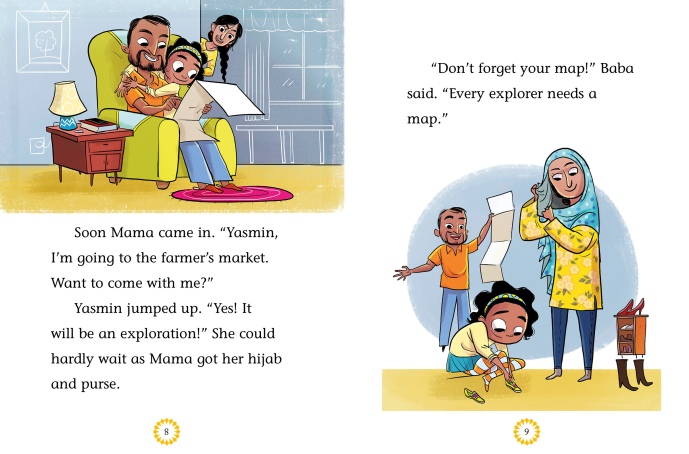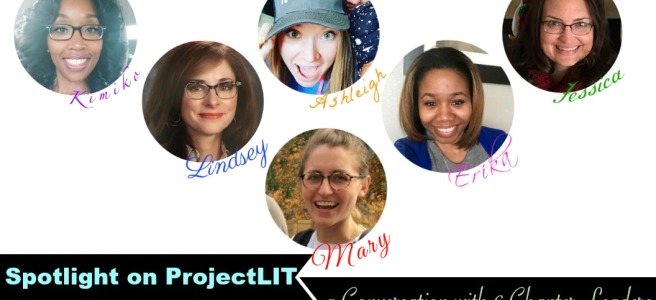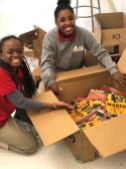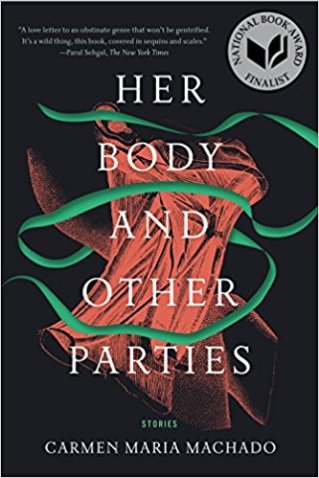Today I am excited to welcome five fantastic educators to #MGBookVillage! Last week I had the opportunity to chat with ProjectLIT founder Jarred Amato on the Books Between podcast (check out that episode here) and was eager to learn more. While I was at NerdCampMI, I met Kimiko, Ashleigh, and Lindsey who lead a great session on ProjectLIT and connected me with other ProjectLIT Chapter Leaders working with middle grade students. I am so grateful to each of these educators who took time out their summer to answer my questions about their experiences with ProjectLIT. I hope you find their answers as helpful as I have. Their responses were so thoughtful and in depth that I decided to break this feature into three parts: Part 1 will focus on introductions and how to run a ProjectLIT Book Club. Part 2 is all about student leadership, community involvement, and that BIG question – how to get the books! Part 3 looks at future plans, favorite books, and advice to new ProjectLIT chapter leaders.
students. I am so grateful to each of these educators who took time out their summer to answer my questions about their experiences with ProjectLIT. I hope you find their answers as helpful as I have. Their responses were so thoughtful and in depth that I decided to break this feature into three parts: Part 1 will focus on introductions and how to run a ProjectLIT Book Club. Part 2 is all about student leadership, community involvement, and that BIG question – how to get the books! Part 3 looks at future plans, favorite books, and advice to new ProjectLIT chapter leaders.
After reading these responses, I’m super excited to launch a ProjectLIT Book Club at my school next year! If you want to know more about ProjectLIT – follow them on Twitter @ProjectLITComm and if you are ready to apply to become a chapter leader, the form is right here!
~ Corrina
Please tell us about yourself!

Kimiko: My name is Kimiko Pettis. I am 6th-8th grade ELA teacher from Chicago, Il. I have been teaching for 11 years in Chicago Public Schools. [You can follow Kimiko on Twitter @kcpteachertips]

Ashleigh: Hi all! My name is Ashleigh Rose and I am a middle school teacher in Southeast Washington, DC. I am the site leader from @projectlitAIM at KIPP DC: AIM Academy in Anacostia! I’ve been teaching in DC for the last seven years. This year, I am leaving five years teaching 6th grade ELA to transition to teaching 7th and 8th grade Writing next year! [You can follow Ashleigh on Twitter @betweenmargins]

Lindsey: I’ve been a middle school librarian for the past 15 years, and previously, I was a 7th grade language arts teacher. I share lessons and ideas for school libraries on my blog, Library Stile, and recently, I’ve started assisting authors with school visits. I’m the Advocacy Chair for the Tennessee Association of School Librarians. I’ve enjoyed meeting with Tennessee’s gubernatorial candidates, representatives, and senators this year and talking with them about the value of school libraries. I am also Vice-President of SE-YA, which is the Southeastern Young Adult Book Festival. Connecting kids with the authors they love is the best! My home life is equally busy with 4 sons and 5 pets. I do manage to sleep. And read. I read more than I sleep. [You can follow Lindsey on Twitter @LindsKAnderson]

Mary: Hi! I’m Mary Thomas, a middle and high school librarian at a charter school in Washington DC. Before becoming a school librarian, I taught upper elementary school (4th & 5th). I actually transitioned to my new school and role in the early Spring, and have the unique opportunity to build a library collection & program from scratch! My school has a space and empty shelves, and I’m working hard to create a library! It is basically my dream job. [You can follow Mary on Twitter @msmarythomas]

Jessica: My name is Jessica Lingenfelter. I am entering my 21st year of teaching this year. I have a bachelor’s degree from The University of Arizona in English and a Master’s degree in Education with an emphasis on Reading from The University of La Verne.I taught high school English, Reading, and ELD (English Language Development) for 15 years. I decided to move to junior high and currently teach 8th grade English and I LOVE IT! I love junior high kids so much and am sad I didn’t make the switch sooner! I love to read and share my passion with my students. It is so exciting to me to see the reading spark illuminated in kids. I am Harry Potter obsessed (yes, my classroom is Harry Potter themed!). In my free time, if I am not reading, I am spending it with my family. I am married to a wonderful husband of 20 years who is an Educational Director at the district office level, and we have two children: Sarah, 17 and Ben, 11. [You can follow Jessica on Twitter @jessicatiara7]

Erika: I’m a secondary librarian in Nashville, TN. I currently work in a middle school that serves grades 5-8. [You can follow Erika on Twitter at @erikaslong]
How did you hear about the ProjectLITCommunity?
Kimiko: I found out about this PLN when I was searching for literacy chats during the 2016-2017 school year.
Ashleigh: I saw a lot of what Jarred was doing on Twitter. I actually reached out to him to ask him some questions and we hopped on the phone that weekend to talk more about Project LIT in March of 2017.
Lindsey: I noticed Jarred Amato’s posts on Twitter during the 2016-2017 school year. Here was this amazing high school English teacher in a neighboring school district making things happen in his school community! He was getting his high school students not only involved and excited about books, but they were solving the problem of book deserts together. How could they provide more access to books in their community and how could they get more culturally relevant, high quality books to kids in the community? I loved the enthusiasm radiating out of this corner of Nashville!
Mary: I am fortunate to have the best friends, one of whom is Ashleigh Rose, another Project Lit leader here in DC. She invited me to attend one of her meetings, I think the first one I made it to was for March by John Lewis. After that I was sold!
Jessica: I heard about Project LIT through Twitter. I saw the application come out and jumped on it immediately. I am so glad to have found Project LIT! The community of educators is amazing and supportive and inspiring.
Erika: I heard about Project LIT Community via Twitter. I actually followed Jarred’s posts and read his blog throughout the year. Toward the end of their first year of Project LIT as a class, I asked Jarred if he and a few students would mind if I interviewed them for a piece I wanted to write for The Horn Book and they obliged.
What made you decide to start a ProjectLIT Book Club in your school?
Kimiko: I was so impressed by the actions of Jarred Amato’s students in regards to community outreach and their desire to increase diverse literature in their school that I wanted to sign up immediately. I completed an application and went straight to Barnes and Noble to purchase books. My goal was to provide students with compelling literature that would reignite their passion for reading, increase their desire to learn about diverse cultures, and help them discuss controversial topics.
Ashleigh: Project LIT for me was a way to formalize and amplify the work and the passion that my students and I were already working daily to cultivate in our classroom. I have always tried to make it my mission to get books into kids hands that represented their lived realities and that they loved and then to give them the space to choose those books, read those books, reach out to authors, and share those books during independent reading in class. For far too long I had struggled to find books that spoke to and saw my kids as real people who exist with real day-to-day lives. I remember the day I finished When I Was The Greatest by Jason Reynolds in 2014 and stormed into my now principal’s office like “THIS IS IT, I FOUND WHAT I’VE BEEN SEARCHING FOR, IT’S THIS.” When I found Project LIT, I realized this was just a supportive community trying to spread that thing that I’d found and that my kids (read: students) were falling in love with in books. Authors like Jason Reynolds, Angie Thomas, Representative John Lewis, Jacqueline Woodson, Renee Watson, Sharon Draper, Nic Stone, and Jewell Parker Rhodes were already doing this work for kids and Project LIT was just showing what happens when you encourage communities and conversations around those texts. I wanted to share that with as many kids, staff, and families as I could. I also felt like there was not always space for kids to have opportunities for authentic leadership or sharing their talents and passions in our curriculum. Project LIT was a way to create those opportunities to amplify student voice and leadership in our school. I had no idea how much kids would take it and run with it!
Lindsey: I am always looking for opportunities for my students to connect with books in a meaningful way. ProjectLIT provides the opportunity for my students and I to explore a variety of perspectives and to build empathy. My school is 89% caucasian, and in the South, and as much as I can, I want to showcase and highlight books that help my students see the stories of everyone in the world, past and present, so that they celebrate diversity. My school is often thought of as existing in a “bubble,” so it’s important that we break out of that bubble and seek to understand what’s going on in our world and be part of meaningful conversations that will help my students have a broader perspective of our world. I also love the service component of ProjectLIT, and I knew my students would accept the challenge of working to eliminate book deserts.
Mary: When I started as a librarian at my current school I knew I wanted to offer robust reading programming. After my experiences observing Ashleigh’s chapter meetings and talking with her about the program I knew Project LIT would be a natural fit for my school. With limited time left in the school year, I wanted to try to squeeze one meeting in before summer, and it worked!
Jessica: I am a pretty spontaneous person and usually jump in head first to try new things. When I saw the application for a chapter leader come out, I jumped at it and haven’t looked back! I knew that starting a student-led book club would only create stronger readers and better critical thinkers! And what better way to get students hooked on books? It was a no-brainer to start this club!
Erika: I wanted to start a Project LIT Book Club in my school as a way to encourage a love of reading while providing access to timely and relevant literature I know students would enjoy and be willing to engage in discussion around.
How often does your ProjectLIT Book Club meet? And where do you meet?
Kimiko: We meet in my classroom usually during second period if I am trying to connect with an author via Skype otherwise we meet during my last period.
Ashleigh: There are two elements to Project LIT at AIM. First, Project LIT is an extra curricular activity – though I encourage kids to read the books during independent reading time in class. This year we met two times a week after school on Tuesdays and Fridays. My kids started calling themselves “LIT Leaders” that attended the Tuesday and Friday meetings where we would listen to the audiobook, discuss big ideas, begin to write discussion and trivia questions, send out Instagram updates, and engage in other bookish pursuits. We also hosted eight full book club meetings this year. These were held on Saturday mornings in our school cafeteria from 10:00 – 11:30 and any students, staff, family members, friends, or other community members were invited. We’re trying a summer meet up at a local park this Saturday, too!
Lindsey: We meet once a month before school for 45 minutes. We have Power Mondays, which are late start days that allow the teachers to be involved in meetings and professional development activities, but the majority of students are at school, hanging out in the gym or cafeteria. We meet in the library.
Mary: So right now the plan is for our middle school and high school groups to meet every other month. Secretly I’m hoping that the student leadership really takes off and they push me to help them organize monthly meetings at both levels! For our first (and only) meeting we met in our school’s theater, which is a big open space that’s sort of akin to a cafeteria.
Jessica: Last school year, our Project LIT chapter met a total of 5 times. We hold our book clubs at 7:30am in our multi-purpose room.
Erika: Because I was new and still getting to know my school and students, and for other logistical reasons, we only hosted two book clubs this year.
What happens at those meetings?
Kimiko: At the meetings we talk about author’s writing style, character relationships, the ending, some students propose questions to guide our discussions.
Ashleigh: We started with just time to hang out and enjoy breakfast for about thirty minutes. Students then took over the reins to lead us in the following activities:
- Welcome Message or Ice Breaker
- Full Group Circle where everyone shared one big takeaway from the book.
- Small Group Discussions
- Trivia
- Book talk and hand out the next book!
Sometimes we added in another activity here or there – but that was the gist of it.
Lindsey: Here’s a typical meeting:
- Sign-In- A student is in charge of greeting everyone and making sure students and community guests sign in.
- Makerspace- We like to have something that kids and guests can work on while we’re waiting for everyone to arrive. We did a book page craft, and we shared our social units with TOWERS FALLING, for example. This allowed kids to engage right away and I find that they overcome shyness or social anxiety when they have a makerspace activity. They began talking about the book while they were working and the meeting hadn’t even officially started yet. It was fun to hear these casual conversations about the books.
- Introductions- We officially start the meeting, introduce ourselves quickly, and a student introduces our community guests.
- Trivia- We have 10 trivia questions about the book. We use Google Slides to display the questions/ answers. I like to start with trivia because it can be a fun ice breaker.
- Discussion- We post a list of discussion questions, and the kids select the questions they want to talk about and drive the conversation.
- Community Guest share- Our guests share about the work they do in our community to help others and how this connects to our reading.
- Commercial for the next meeting- There’s a quick book talk for the next book and the meeting info is shared.
Mary: I took the agenda for our meetings directly from Ashleigh and the Project Lit leader resources. Here it is -I put the times on there because it helps me & the students manage time during the meeting!
8:00 – 8:20am: Breakfast & Sign In
8:20 – 8:25am: Ice-Breaker
8:25 – 8:35am: Full Group Circle
8:35 – 8:50am: Small Group Discussion
8:50 – 9:10am: Trivia!
9:10am: Group Photo! & Clean up
9:23am: Head to 2nd period
Jessica: We talk and EAT! I think that the fellowship is a big part of Project LIT. I like to give a lot of time for students and community members to discuss both about the book and about themselves! In general, our schedule is usually something like this:
First 10 minutes: get food, talk, find your seat, get acquainted, etc
20 minutes: Discuss the book! The students at the table lead the discussion based on questions they created
10 minutes: Trivia (it’s a fierce battle!!). It is so much fun!
Last 10 minutes: Raffle drawings, wrap up, more food, discussion, go to class 🙂
Erika: We followed the Project LIT agenda for book clubs–discussion and trivia questions.
Stop back tomorrow for Part 2 to learn how ProjectLIT empowers students to take leadership roles, how each chapter leader engaged their community and worked on including service learning projects, and advice about how to get the books!
SaveSave
SaveSave
SaveSaveSaveSave
SaveSave
SaveSave





 Yesterday (
Yesterday (






 Today I am excited to continue the conversation with ProjectLIT Chapters Leaders Kimiko, Ashleigh, Lindsey, Mary, Jessica, and Erika.
Today I am excited to continue the conversation with ProjectLIT Chapters Leaders Kimiko, Ashleigh, Lindsey, Mary, Jessica, and Erika. 








 students. I am so grateful to each of these educators who took time out their summer to answer my questions about their experiences with ProjectLIT. I hope you find their answers as helpful as I have. Their responses were so thoughtful and in depth that I decided to break this feature into three parts: Part 1 will focus on introductions and how to run a ProjectLIT Book Club.
students. I am so grateful to each of these educators who took time out their summer to answer my questions about their experiences with ProjectLIT. I hope you find their answers as helpful as I have. Their responses were so thoughtful and in depth that I decided to break this feature into three parts: Part 1 will focus on introductions and how to run a ProjectLIT Book Club. 









 I’m your host, Corrina Allen – a mom of two, a 5th grade teacher, and thinking about how much I LOVE our public libraries and how much they are needed. My daughters and I just launched our summer Library Crawl where we try to hit as many public libraries in the area as can and explore their unique services and collections and just get to know them. Libraries are the heart of our communities. Please support them.
I’m your host, Corrina Allen – a mom of two, a 5th grade teacher, and thinking about how much I LOVE our public libraries and how much they are needed. My daughters and I just launched our summer Library Crawl where we try to hit as many public libraries in the area as can and explore their unique services and collections and just get to know them. Libraries are the heart of our communities. Please support them. Ward – or at least referencing her work
Ward – or at least referencing her work 







 features podcasts for educators, created by educators. For more great content visit
features podcasts for educators, created by educators. For more great content visit 










 Rebecca Caprara is the author of THE MAGIC OF MELWICK ORCHARD, releasing September 1, 2018 with Carolrhoda Books, an imprint of the Lerner Publishing Group. She graduated from Cornell University and practiced architecture for several years, before shifting her focus from bricks to books. An avid globetrotter, she has traveled to over 50 countries, and has lived in Italy, Singapore, and Canada. She is now growing roots in Massachusetts with her family.
Rebecca Caprara is the author of THE MAGIC OF MELWICK ORCHARD, releasing September 1, 2018 with Carolrhoda Books, an imprint of the Lerner Publishing Group. She graduated from Cornell University and practiced architecture for several years, before shifting her focus from bricks to books. An avid globetrotter, she has traveled to over 50 countries, and has lived in Italy, Singapore, and Canada. She is now growing roots in Massachusetts with her family.  Laura Diehl is a freelance fantasy illustrator and visual storyteller who specializes in children’s and middle grade fantasy art. Laura has been an illustrator since 2003, working with clients such as: Routledge, Continuum New York, Pearson Education, David Fulton, and Mattel. Her artwork has appeared on numerous books covers, in magazines, and even an iPad game. Additionally, her artwork has been juried into Spectrum, New Master of Fantasy, won the Illustrators of the Future Grand Prize, and was nominated for a Chesley.
Laura Diehl is a freelance fantasy illustrator and visual storyteller who specializes in children’s and middle grade fantasy art. Laura has been an illustrator since 2003, working with clients such as: Routledge, Continuum New York, Pearson Education, David Fulton, and Mattel. Her artwork has appeared on numerous books covers, in magazines, and even an iPad game. Additionally, her artwork has been juried into Spectrum, New Master of Fantasy, won the Illustrators of the Future Grand Prize, and was nominated for a Chesley.












 Heidi Lang and Kati Bartkowski are a writing team of two sisters with twenty years of experience in Judo. Heidi likes to fling food across her stove while attempting to cook new dishes, and Kati enjoys trying new cuisine at fancy restaurants. Between the two of them, they love creating characters that kick butt both inside and outside the kitchen.
Heidi Lang and Kati Bartkowski are a writing team of two sisters with twenty years of experience in Judo. Heidi likes to fling food across her stove while attempting to cook new dishes, and Kati enjoys trying new cuisine at fancy restaurants. Between the two of them, they love creating characters that kick butt both inside and outside the kitchen.